.jpg)
(by Michael S. Parker)
by John P. Pratt
6 Feb 2014 (1 Reed)
©2014 by John P. Pratt. All rights Reserved.
| 1. Glastonbury Traditions |
| 1.1. Mary's Death Date |
| 1.2. Mary's Birth Date |
| 2. Calender Links |
| 2.1 Links to Jesus |
| 2.2 Links to Great Women |
| 2.3 Links to Adam and Eve |
| 3. Mary's Constellations |
| 3.1 The Virgin |
| 3.2 The Infant Prince |
| 4. Conclusion |
| Notes |
The Virgin Mary may well have been given the most important assignment of any woman who ever lived: being the mother of Jesus Christ, the Son of God. What do we know about her? Do we even know how old she was when she gave birth to the blessed fruit of her womb? How long did she live? What happened to her after her son was crucified? This article proposes answers to those questions.
.jpg) |
When this author began his work, he considered a wide variety of ancient works which claimed to record birth and death dates of many of the ancient prophets and patriarchs. As sacred calendars were discovered, they provided a way to check on the validity of these sources. Two examples are the Book of Jubilees and the Book of Jasher. Each provided many precise dates. When those dates were subjected to the scrutiny of checking them on a variety of sacred calendars, clear patterns were discovered. All of the dates given in the Book of Jubilees appear to be totally random. On the other hand, nearly every date in the Book of Jasher resulted in an amazing interconnected web of holy days, where the patriarchs and their wives were nearly all born on sacred dates on both the (Perpetual) Hebrew Calendar and also the Native American Sacred Round.
A very important feature of these interwoven patterns was that there was almost always a parent-child link, meaning both parent and child were born or died on the same day on one sacred calendar. Moreover, there were husband-wife links as well. And usually the dates were not only holy days on those two calendars, but also on many other sacred calendars as well. Thus, this author has accepted the Book of Jasher as authentic, whereas most scholars reject it as a medieval invention. On the other hand, to me the Book of Jubilees is fiction because all of the dates within it seem spurious and invented.
This article uses the same method to confirm at least part of the traditions of Glastonbury. In addition, the web of links to other dates such as those of Rebekah, Rachel, and Miriam also provide confirmation of their proposed birth and death dates. In such a linked web, each point tends to testify of the correctness of all other points, because of the statistical odds against so many links even being possible by random chance.
A few general explanations seem needed. First, let it be understood that nearly all of the dates listed in all of my papers are "proposed", but they are usually referred to as if they were certain. If the word "proposed" were put before every date, the reader would soon tire of it. The precise dates of all events mentioned in this article are listed in the Religious Chronology Summary on my website, along with references to the papers in which they were derived. Thus, most dates of those events are not explicitly given in this article. Moreover, the web of interconnectedness is such a strong witness to the validity of every date that in my view there really is very little doubt that nearly all proposed dates are correct. Also many of the dates are firmly tied to history, such as the date of the resurrection of Jesus Christ.
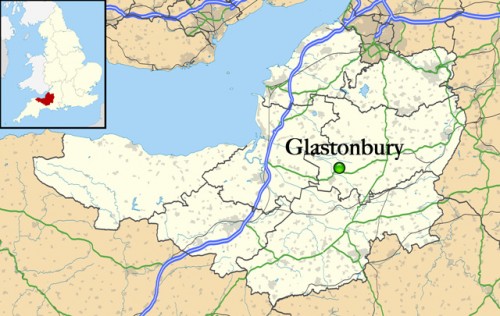 |
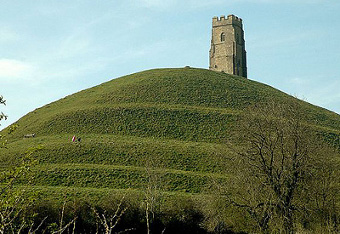 |
The best quotation known to me of a historical record of Mary's death date is the following:
"The old ecclesiastical records of Glastonbury, confirmed by many other ancient writers, also state that the Virgin Mary departed this life in the year AD 48. Several other early documents are reputed to bear this out."[1]
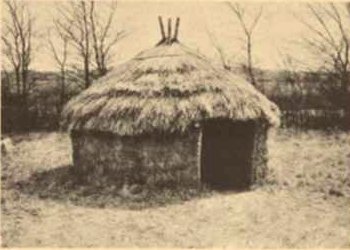 |
Just looking at each of her holy dates alone, the most impressive is her death date on the Jubilee Calendar. First, it is the last day of the year, which is the Last Day of the Feast of Tabernacles, one of the holiest days of the entire year. Second, it was also the last day of an entire jubilee of 49 years. That is a sacred year and greatly increases the rarity of the day. If that were the only holy day it would be impressive because that day only occurs once every 49 years.
After Mary's death date was discovered, it wasn't really expected that her birth date could be found because the year was not known. On the other hand, the tradition is that she was a young virgin. In those days betrothal at age 14-16 was common, if not expected, so only a few years needed to be searched.
As has been reported in the earlier papers, there is generally a link between the birth dates of a parent and child on at least one sacred calendar. That means that either the birth or death date of the parent will coincide with the birth or death date on one of their children. In this case, a link between Mary and Jesus was clearly expected. But no such dates existed in the three year interval considered, which was surprising. That is one reason her birth date had not be found before.
Then an exhaustive search was done looking for an impressive date which would link to her death date, because very often there are also birth-death links. The search resulted in one of the most impressive dates in history. As will be explained below, to me there is no question that it is Mary's birth date because of all the links to several of the great women of history, including even to Eve. Once that date was found, many links were found to the life of Jesus, but just not to either his birth or death date as had been assumed earlier.
The proposed time for the birth of the Virgin Mary is Sun 5 Dec 19 BC, between 6 a.m. and noon. That time interval was sacred on six sacred calendars: 1 Kislev (PHC), 1 Birth (V), 1 Birth (M), 1 Wind (SR), 1 Autumn (Feast of Trumpets UE), and 1 Eliashib (Priest). But in this case, two of the holy days count extra because they fall not just on one of the twenty per year, but on the very day representing the event. That is, on both the Venus and Mercury Calendars the day is 1 Birth, which is the one day per cycle that represents birth. That is a stunning birth date, one of the rarest in all of history. Its correctness is witnessed by many links to those same women as is her death date.
Given that the birth date of Christ was one of the first established in this author's work, being the evening preceding Thu 6 Apr 1 BC, we can now calculate that Mary was betrothed (engaged) at age 16, and Jesus was born when she was 17 years old. The above portrait of Mary was chosen because she could be that age and because she has blond hair which matches some traditions.
There are a nearly unbelievable number of calendar links between the proposed birth and death dates for Mary and many other notable people and events of Biblical history. The word "links" is used in my work to refer to when two events happen on the same day of the same sacred calendar. In Mary's case there are so many, they are divided into three areas: those with her son Jesus, those with the ancient great women, and those with Adam and Eve.
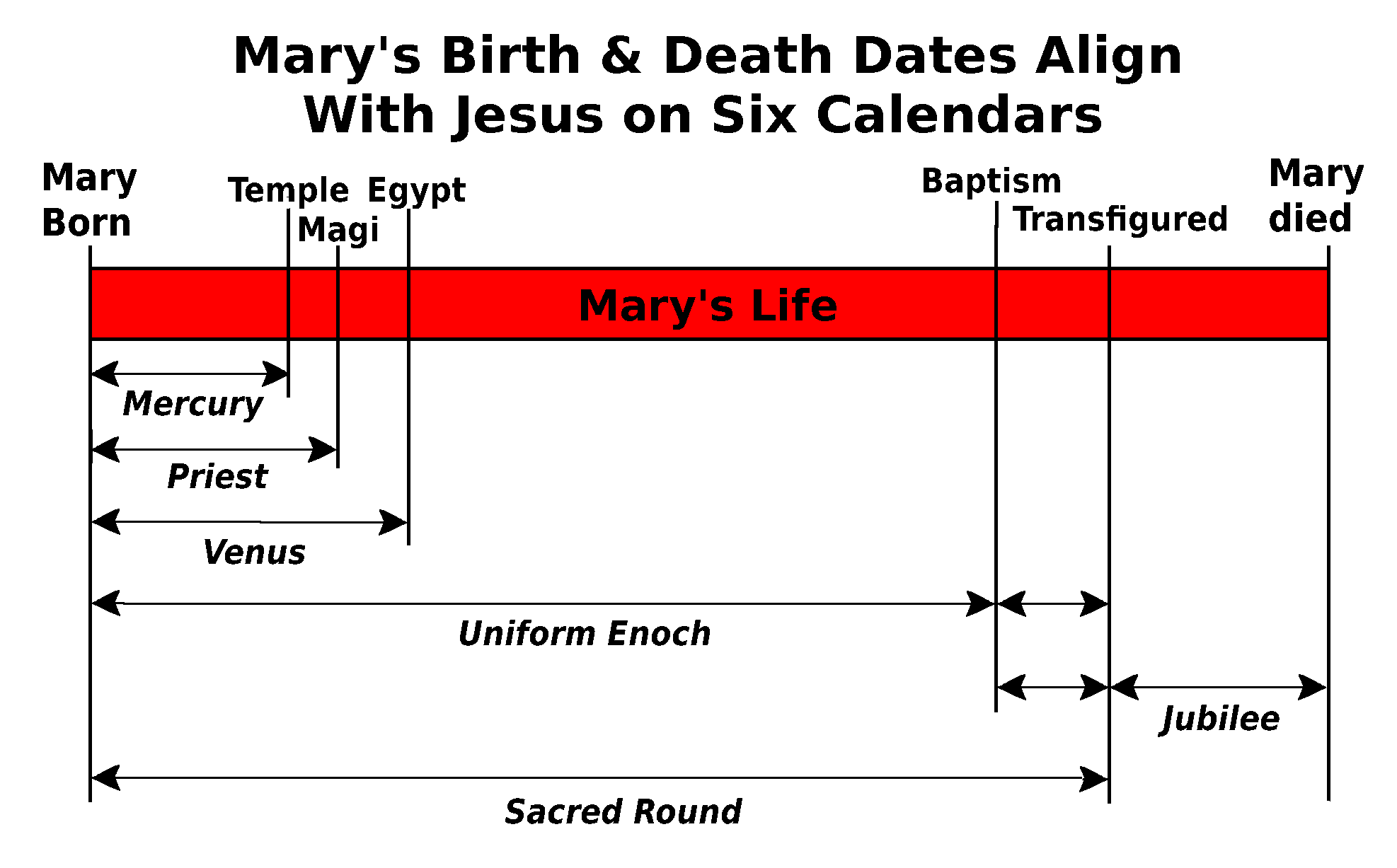 |
First of all, the day on which the law of Moses commanded her to present Jesus to the priest at the temple, was the day 1 Birth on the Mercury Calendar. That coincided with her day of birth, also being 1 Birth (M).
Next, the day proposed for the visit of the magi only thirteen days later coincided with her birthday on the Priest Calendar. It was also the Feast of Firstfruits (PHC) and holy on many calendars, but right now only ties to Mary's birth or death dates are being considered.
The day on which the holy couple began their trip to Egypt coincided with her birthday also, both being 1 Birth on the Venus Calendar. Those are all the known links to events in both the lives of Mary and her son.
The next two links are to the day of the baptism of Jesus. That day completed exactly 47 Uniform Enoch years to the very day from her birth. It was also exactly 19 Jubilee years from that baptism date to her death. That is very unusual to have to links to an event in someone else's life. It would be more expected to have such links to a person's own baptism date. The question arises of just when Mary was baptized. Many people were baptized on the same day as Jesus because it was the Day of Atonement on the Judean Calendar, the day for making covenants with God. Was Mary baptized too that same day?
Even more surprising is that there are three links to the day of the Transfiguration of Jesus. That day completed 50 Uniform Enoch years from her birth. Moreover it completed exactly to the very day 70 Sacred Rounds of 260 days each. That is, starting on her birth date as day 1, the day of the Transfiguration was day number 18,200, the last day of 70 Sacred Rounds. And finally, it was also 22 Jubilee years from that day to her death. The meaning of those three links eludes me, but they should be reported as being beyond chance. Something very important may have been going on in her life also on that day.
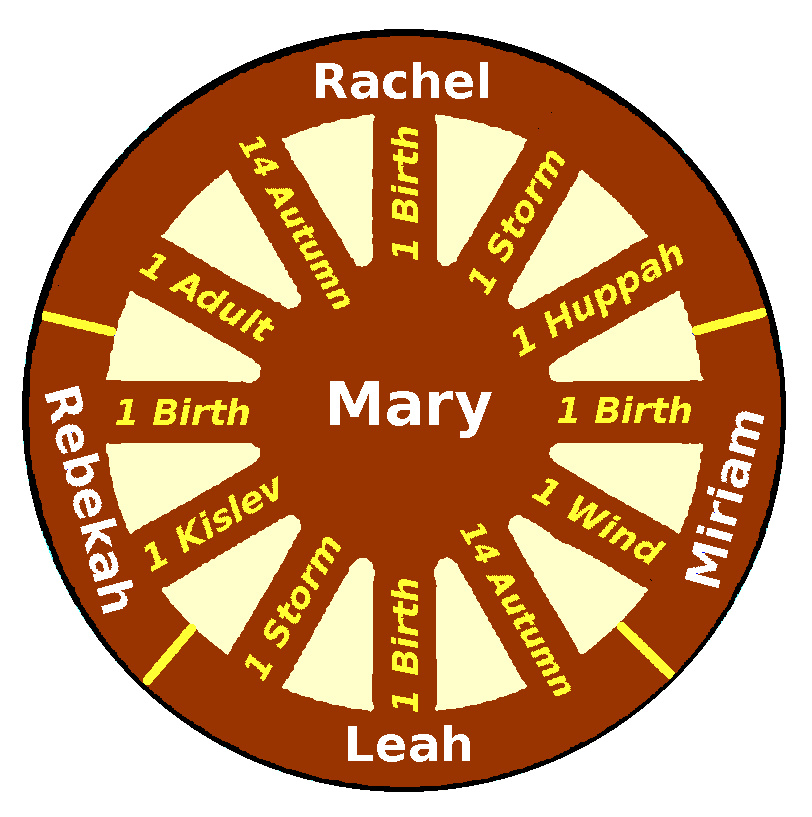 |
The first of these is Miriam, the sister of Moses. The name Mary is the English translation of the Hebrew name Miriam, and this similarity alone is important because the names of prophets and prophetesses are given by inspiration and carry deep meaning.
Another woman with which one would expect to find ties is Rachel. First, both Rachel and Mary gave birth to a choice son at Bethlehem, even though neither lived there. Moreover, while Rachel was giving birth to that son Benjamin, Rachel died there. So Mary and Rachel are tied through birth/death events at the same city. Finally, the slaughter of the infants by King Herod fulfilled the prophecy of Jeremiah that Rachel would be weeping for her children (Mat. 2:18).
Comparing the proposed birth and death dates for Mary to those of all the great women published so far indeed led to an amazing number of links to Rebekah, Rachel, Leah and Miriam. On the other hand, there were almost none to other great women.
The number of links between the birth and death dates of Mary and those four other women was thirteen. That is an incredible number of links between ten possible dates. That is so unusual that it was clear that those four women each had a link to Mary, whereas not always to each other. In other words, it is as if Mary is at the hub of a wheel, with links like spokes going out to the other women at the circumference. That is shown in Fig. 3 for 12 of the links. The links to Leah are all to her birth date, and Leah and Rachel were twins, so the links may really be only to Rachel. Nevertheless, the links to Leah are real and so are shown. After all, Mary is a descendant of Leah, mother of Judah.
In Fig. 3, the day name on each spoke is a holy day, being either Mary's birth or death date, which matches the birth or death date of the woman the spoke connects with. The most remarkable feature is that all five women were born on 1 Birth (V). The day only occurs once every 585 days, so that is absolutely amazing for all to be born on the very day representing birth. The other spokes represent days on five different sacred calendars.
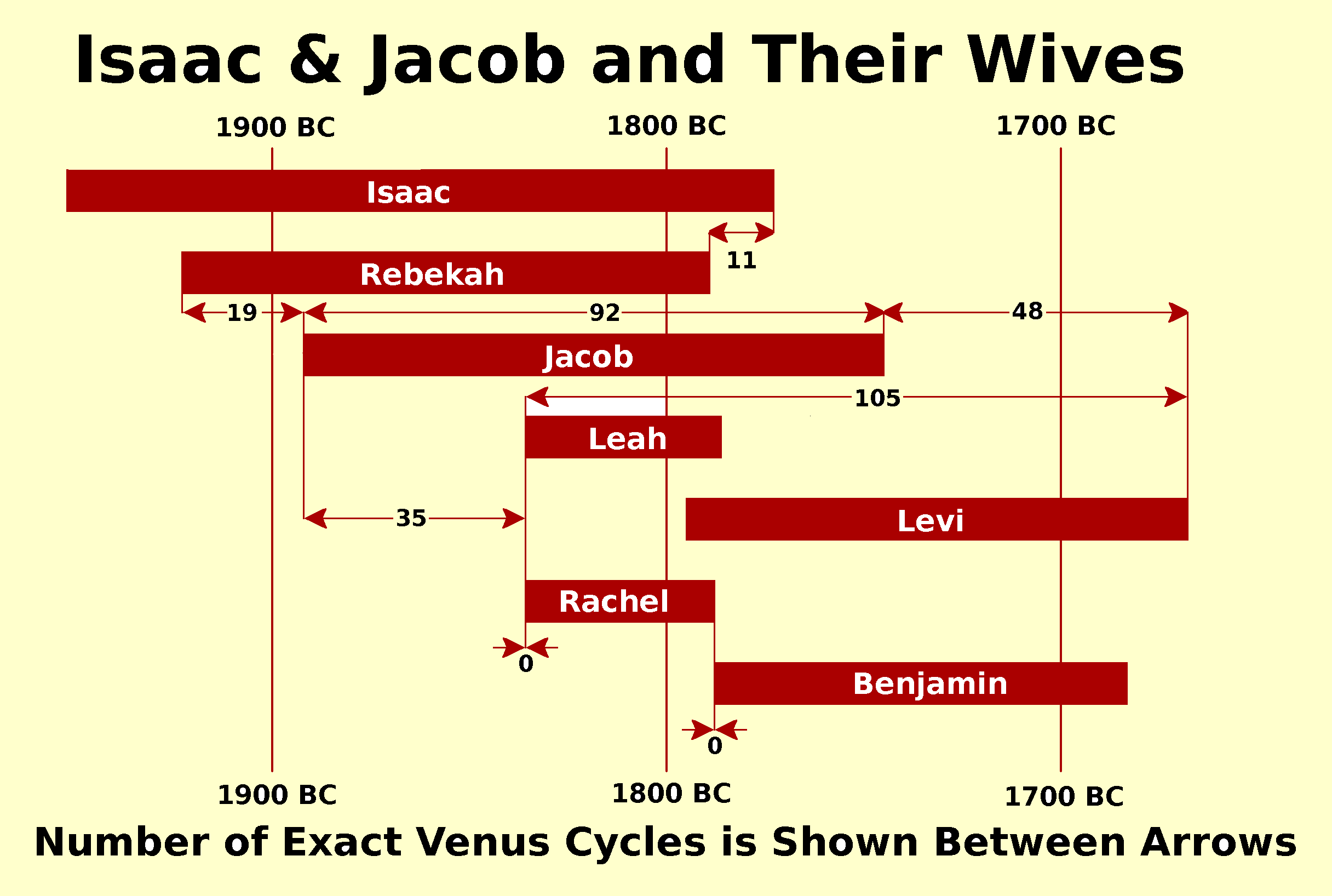 |
There are so many links between those four women and their husbands and children that it would be very difficult to show them all in one illustration. To simplify it, Fig. 4 presents all of the known such links on only the Venus Calendar for Rebekah, Leah and Rachel. Note that in every case, each woman is linked to her husband and to her son by birth or death dates. This illustration is included to show how their birth and death dates were determined long before Mary's and by an entirely different method. Thus, the amazing number of links to Mary with the very women expected (5 links to Rachel!) provide powerful additional witnesses both to the correctness of Mary's dates as well as those of the women she links to.
Just how important is the Virgin Mary in the big scheme of things? How would you rank Mary among all the women of the earth? In the former section we saw that instead of Mary being somewhat like the great women of Rebekah, Rachel and Miriam, it was really more the other way around. That it, all of them were something like her, as if she were the hub and they the spokes.
 |
In my work, three witness are usually required for me to mention a calendrical link as being significant. Here we have five links, and the last three are all between the Fall of Adam and Mary's death.
Another interesting point is that Adam was exactly 66 Uniform Enoch years old when he fell. Mary lived 66 Uniform Enoch years plus two weeks. That two week difference corresponds to the two weeks between the Fall of Eve and the Fall of Adam.
The results of the previous section raise the question of just what Mary has to do with the Fall of Adam. One of the main focus points of the mission of her son Jesus was to overcome death, which had been introduced by Adam and Eve. As Paul said, "For as in Adam all die, even so in Christ shall all be made alive" (1 Cor. 15:22). Adam and Christ are closely tied together.
Mary is also linked to Adam and Eve because her son is. This was actually explicitly stated to the serpent on the day on which Adam, Eve and the serpent were judged by the Lord for their actions. That only became clear to me on the very day this article is being published (1 Reed, the birthday of Jesus Christ on the Sacred Round), when the following three paragraphs were written.
.jpg) |
And I will put enmity between thee and the woman, and between thy seed and her seed; it shall bruise thy head, and thou shalt bruise his heel. (Gen. 3:15)
Until this morning, the next two sentences read: "This great promise to Eve is that her seed, meaning descendant, would someday overcome the serpent, who enticed her to fall. Because of this scripture, Jesus Christ is sometimes referred to as the Seed of Woman". That was my understanding until today, and surely it is stated several times in my earlier work. What has changed now is that it was clearly a forced interpretation that this was a promise made to Eve. The Lord was addressing the serpent! Eve is not explicitly mentioned, but only "the woman", who has been assumed to be Eve. After all, Eve had not even been named yet, and was called "the woman" just two verses earlier and the next verse. But when Adam was given his punishment, Eve is clearly referred to as "your wife".
Jesus is indeed the descendant of Eve and "seed" often is used to refer to descendants. He is also a descendant of Adam and everyone in Mary's genealogical line. However, when it comes to identifying one particular woman, that is, "the woman", He was actually the seed of Mary. Mary was the mother of Jesus Christ. Thus, it now appears to me that it may be Mary who was referred to as "The Woman".
Everything mortal that Jesus inherited came through his mother. In particular, mortality itself, meaning being subject to death. So with some reflection, it should not be so surprising that there is a triple link between the Fall of Adam and the Virgin Mary.
.jpg) |
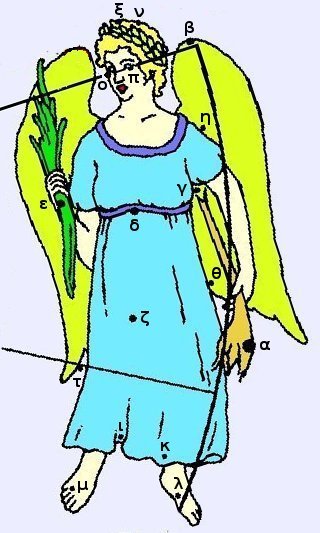 |
There is another very important constellation which was either lost to the Greeks or changed by them. There is a tradition about how one Greek astronomer created a constellation in honor of Queen Bernice. He named it Bernice's Hair (Coma Berenices). It is not on other ancient lists such as that of the Persians. The location of Bernice's Hair is near the Virgin. In the Egyptian star map at the temple at Dendera, the constellation is shown as a queen (usually identified with Isis) holding an infant god (Horus).
A few years ago, this author undertook the project of restoring that lost constellation. It was noticed that the stars in that area exactly fit the shape drawn at Dendera, namely a woman sitting on a chair, holding up an infant-sized man. There is an entire article devoted to restoring that constellation, which was named "The Infant Prince". The figure was drawn to depict Mary holding the infant god Jesus.[2] A comparison of the ancient and modern renditions of this constellation is shown in Fig. 9.
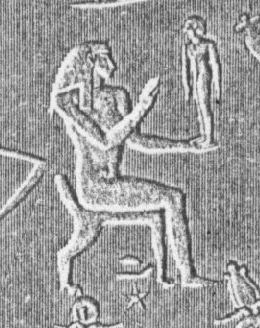 |
 |
Starting from the historical date of AD 48 for the Virgin Mary's death, precise dates are proposed for both Mary's birth and death. It is then shown that her proposed dates tie to sacred events in the life of Jesus, including all of the Biblical key events of his youth with her. Moreover, her two dates are identical to the already published birth and/or death dates of Rebekah, Rachel, Leah and Miriam on five different sacred calendars in thirteen different ways. Then it is shown that Mary's dates link to the Fall of Adam and Eve in five different ways. Finally it is reviewed how there are two constellations which seem to symbolize Mary, attesting to her key role in history. It is concluded that such is a testimony that she may well be the most important woman in all of history, being the mother of the Son of God.